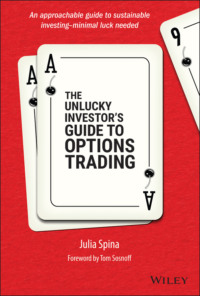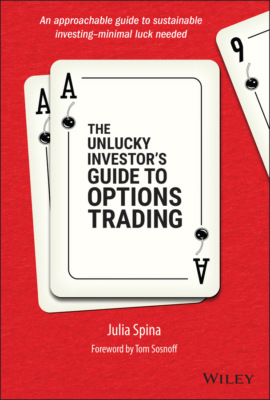Loe raamatut: «The Unlucky Investor's Guide to Options Trading»
The Unlucky Investor’s Guide to Options Trading
Julia Spina
Coauthored by Anton Kulikov
Foreword by Tom Sosnoff

Copyright © 2022 by tastytrade, Inc. All rights reserved.
Published by John Wiley & Sons, Inc., Hoboken, New Jersey.
Published simultaneously in Canada.
No part of this publication may be reproduced, stored in a retrieval system, or transmitted in any form or by any means, electronic, mechanical, photocopying, recording, scanning, or otherwise, except as permitted under Section 107 or 108 of the 1976 United States Copyright Act, without either the prior written permission of the Publisher, or authorization through payment of the appropriate per‐copy fee to the Copyright Clearance Center, Inc., 222 Rosewood Drive, Danvers, MA 01923, (978) 750‐8400, fax (978) 750‐4470, or on the web at www.copyright.com. Requests to the Publisher for permission should be addressed to the Permissions Department, John Wiley & Sons, Inc., 111 River Street, Hoboken, NJ 07030, (201) 748‐6011, fax (201) 748‐6008, or online at http://www.wiley.com/go/permission.
Limit of Liability/Disclaimer of Warranty: While the publisher and author have used their best efforts in preparing this book, they make no representations or warranties with respect to the accuracy or completeness of the contents of this book and specifically disclaim any implied warranties of merchantability or fitness for a particular purpose. No warranty may be created or extended by sales representatives or written sales materials. The advice and strategies contained herein may not be suitable for your situation. You should consult with a professional where appropriate. Further, readers should be aware that websites listed in this work may have changed or disappeared between when this work was written and when it is read. Neither the publisher nor authors shall be liable for any loss of profit or any other commercial damages, including but not limited to special, incidental, consequential, or other damages.
For general information on our other products and services or for technical support, please contact our Customer Care Department within the United States at (800) 762‐2974, outside the United States at (317) 572‐3993 or fax (317) 572‐4002.
Wiley also publishes its books in a variety of electronic formats. Some content that appears in print may not be available in electronic formats. For more information about Wiley products, visit our web site at www.wiley.com.
Library of Congress Cataloging‐in‐Publication Data is Available:
ISBN 9781119882657 (Hardcover)
ISBN 9781119882671 (ePDF)
ISBN 9781119882664 (ePub)
Cover Design and Image: © Cassie Scroggins
Author Photos: © Garrett Roodbergen
To Beth, Ken, and Joe Spina, as well as all the smaller, fuzzier Spinas that have joined us along the way
The ace‐ace‐nine is an inside joke at tastytrade and quite possibly the most annoying way to lose a hand of blackjack. Blackjack, for those unfamiliar with gambling, is a game between a dealer and player where the objective is to get closest to 21 without exceeding it. Face cards are worth 10 and aces are worth either 1 or 11. Imagine being at a blackjack table sitting pretty with 20, and the dealer is showing an ace. They confirm they don't have blackjack, turn over their second card and show another ace. The round is basically won and done because the dealer has a terrible hand, totaling 2 or 12, against your 20. The dealer draws their third card and reveals a nine, and by the time you've done the math, the house has already taken your chips.
Foreword
I've come a long way from my knuckle‐dragging pit trading days of the 1980s and 1990s. I take the wrapper off hot dogs when I eat them now, and I have also learned a few things about investing after 20 years of meeting people all over the country and teaching them how to trade. One crazy takeaway: Unlucky investors usually make the best traders. Why? Because anyone can get lucky and profit from a random investment, but in the small world of successful traders, the common denominator is quantitative skill. Another crazy takeaway: Anyone can learn these skills with access to the right information.
Way back when TD Ameritrade bought thinkorswim in 2009, I negotiated with every bit of leverage I had to personally keep the domain name, tastytrade.com. I had purchased the web address for $9.95 years earlier through GoDaddy, and I was convinced, just as I was with thinkorswim, that the name tastytrade would work. I have no idea why I loved tastytrade.com, but sometimes hunches just seem to work out. tastytrade's raison d'être was to fill the void in the financial media and offer up an untested, goodwill model built around raw, math‐based content. We've spent the last 10 years obsessively building client engagement by introducing complex financial strategies to retail investors. We still answer questions 24 hours a day and teach lessons from what we learned as market makers and software entrepreneurs: all for free. We truly are the guest who won't leave, but we believe that nonstop client engagement is core to motivating traders.
I have so many special memories from the last two decades, but one of my favorites was a strange trading story from an early 2001 trip to the desert. It was the first time we did a live trading show in Las Vegas, and a big trader at the event asked me how long it would take to get a fill on a large order using our platform. When I asked for his order, the client told me he wanted 10,000 spreads. This was before electronic spread executions existed, and I figured he was bullshitting me. But, as a show of good faith (and because I didn't want to back down), I told him we'd fill the order within one second. The client was convinced it wasn't going to happen, so I was pretty pleased when I told him, hand signal and all, that his order was filled in less than a second and the price improved by a nickel. We made asses of ourselves, but this is how it all began. Over the years, we continued to form unbreakable relationships with hundreds of thousands of amazing friends, traders, and investors. We gambled together, ate dinner together, had drinks at the bar, laughed when we made money, and cried when we lost money. We told jokes, embarrassed ourselves, humbled each other, and tortured our friends. We focused on building those relationships not only because it was a blast but because we also really saw how it motivated people to learn how to trade and participate in the market. It was key to the success of thinkorswim, and it inspired the founding of tastytrade.
When we started tastytrade, our proving ground was an old hip‐hop studio in downtown Chicago. It was a third‐floor walk‐up with a piano as the receptionist's desk and a drum set in the middle of the living room. Old album covers and broken musical instruments were everywhere, yet the energy was undeniable. Our research team consisted of a Guitar Hero champion in a hot dog suit, a few interns, and an ex‐market maker. Our mentor was a sports shock jock whose claim to fame was having sex on the 50‐yard line at Soldier Field, and to top it all off, we had hired a bunch of random comedians from Chicago's famed Second City. Thank God we knew how to trade because we had no clue how to do media. Even worse, I will never forget the day we decided to do HD quality video. I thought, “No way is that what I look like.” That's why tastytrade is so awesome because we figured out a totally new model of financial media when the odds were against us.
Lucky investors never figure things out because they never have to: They simply follow the herd and hope for the best. We refused to follow traditional financial media down the path of self‐promotion and financial irrelevance. We found smart people, fed them cheap lunches, made them work crazy hours, gave them free snacks, and mostly let them do their own thing. The result? We changed the world of strategic investing.
We knew early on that a book about options trading would add a new layer to our model of engagement and be a powerful tool for creating financial content. Eighteen years ago, I locked myself in our old conference room with one of our cofounders, and we tried to write a book. We hired a professional writer, cleared our schedules, and made the book a priority. Three days later and one and half pages in, we fired the writer and quit the book project to protect our friendship and the future of our firm. Fast forward to early 2021, and I was again bitten by the book bug, but this time, I knew I wasn't up to the task. I asked, as nicely as I am capable of, for two of our young, smart researchers to help. I said, “It's all yours.” Julia and Anton accepted the challenge, and they totally nailed it. I truly believe this is the most logical, informative, and comprehensive book on strategic options trading ever compiled. Unlucky investors can rejoice. No book will ever be a one‐size‐fits‐all holy grail for options trading, but The Unlucky Investor's Guide to Options Trading is the closest thing we have.
Tom Sosnoff
Preface
If the conditions are just right, extraordinary things happen when many individual pieces come together: Water molecules organize and form snowflakes; Cells arrange and create organs; Jet streams combine and cause tornadoes; Grains of sand rally and produce avalanches; Investors panic sell and induce financial crashes. Complex systems are composed of many interacting parts, and emergence occurs when these parts organize to create collective phenomena that no one part is capable of creating alone. Complex systems can be found in nearly every discipline, and the mathematics describing emergent properties is not only fascinating but indicates fundamental similarities between seemingly unrelated complex systems. The extinction of a species of fly due to an invasive species of frog has really nothing to do with financial markets, yet the dynamics of the fly population undergoing ecological collapse look nearly indistinguishable from that of a stock undergoing economic collapse. Many physicists gravitate toward finance because physical systems and financial systems can be analyzed with similar theoretical, statistical, and computational tools. It was my interest in those mathematical connections that drew me to finance initially. However, after placing my first trade at the start of the 2020 crash, I quickly learned the importance of financial intuition as well, particularly when trading options.
A trader's intuition comes from experience, but a trader can more efficiently build that intuition by supplementing market engagement with some basic trading philosophies. Many of the papers, books, and blogs I read as a new options trader offered detailed coverage of options theory and its mathematics, but I never encountered a resource that explicitly laid out the most essential elements of practical strategy development. Without a system of core trading principles, applying financial theory, interpreting and analyzing data, and cultivating any sense of market intuition was challenging. However, once a foundation of options trading fundamentals was in place, overcoming the options learning curve became a considerably more manageable process. In my personal case, this foundation developed from conversations with my coworkers at tastytrade (most of which were debates with Anton Kulikov), watching options markets regularly, using options data and theory to build actionable strategies, and a lot of trial and error. My goal in writing this book is to help new traders build their own intuitions more effectively by breaking down the philosophies that formed the basis for my own, beginning with a bit of math and market theory and building from there. Nothing substitutes for experience, and investors' first options trade will likely teach them more than any book. However, it's my hope this framework that Anton and I organized will allow new traders to enter the options market with confidence and gain meaningful value from their first trading experiences, in both the monetary and educational senses.
Julia Spina
Acknowledgments
This world is full of uncertainties, but I'm fairly certain this project would have ended in disaster without the hard work of some very talented people. First and foremost, this book would not have been possible without Tom Sosnoff. Tom originally proposed the project and has wholeheartedly supported my work and opinions throughout this entire process. He is a great boss and never short of awesome restaurant recommendations. The primary editor, Erika Cohen, has not only been highly competent but also wonderful to work with. Involved since the beginning, she played a huge role organizing our ideas, and her insights greatly enhanced the readability and accessibility of the material. I wish only the best for her and her family. The technical editor, Jacob Perlman, has also been crucial in this book's development. His work at tastytrade years ago laid the groundwork for many of the ideas presented in this book, and it continues to inspire retail traders to this day. His mathematical expertise has improved the accuracy and presentation of the technical concepts covered, and I cannot speak more highly of his abilities.
On the publishing front, Jeff Joseph has been instrumental in transforming our series of drafts into a proper book. He has been immensely helpful in organizing the logistics of the publication process, offering creative advice, and establishing our relationship with Wiley. This book would not have been possible without everyone on the highly skilled editorial team at Wiley, who have all put an exceptional amount of effort into this book. Many people have contributed to the project throughout this process, but those I have collaborated with most closely include Bill Falloon, Purvi Patel, Manikandan Kuppan, Susan Cerra, and Samantha Wu. I'd also like to acknowledge the artistic contributions of Cassie Scroggins, who did a fantastic job designing the cover.
I am also grateful for the content advice from Thomas Preston, who never shied away from my many phone calls, and the writing advice from Vonetta Logan. It should be noted that everyone at tastytrade, especially the research team, has directly or indirectly had a hand in making this book possible. The ideas presented in this book were not built from scratch but rather the successes and failures of all the talented content creators at tastytrade over many years of collaboration.
Julia Spina
About the Authors
Julia Spina is member of the research team and podcast co‐host at tastytrade where she works as a financial educator and options strategist. Drawing from her background in physics and experience with signal processing and data analysis, Julia introduces viewers to topics in quantitative finance and their applications in options strategy development. Prior to transitioning into finance, Julia worked as a regenerative medicine research scientist before attending the University of Illinois at Urbana‐Champaign in 2015. At the University of Illinois, she earned bachelor's degrees in engineering physics (2017) and applied mathematics (2017) and a master's in physics (2018). Her research focus throughout her graduate and undergraduate studies was experimental quantum optics, and her primary projects included investigating the effects of measurement in optical quantum systems and using single‐photon sources to determine the lower limits of human vision and perception.
Anton Kulikov is a member of the research team and podcast co‐host at tastytrade and a columnist for the financial lifestyle magazine, Luckbox. With a background in finance, data science, and education, he has spent the last four years developing innovative strategies for the retail options market and educating traders in fundamental economic theory on the show. Anton attended the University of Illinois at Urbana‐Champaign where he earned bachelor's degrees in finance (2018) and economics (2018) and worked at the Margolis Market Information Lab. During his time at the University of Illinois, Anton developed coursework on derivatives and capital markets, and taught classes and workshops on financial software at the Gies College of Business.
Tom Sosnoff is an online brokerage innovator, financial educator, and the founder and co‐CEO of tastytrade. Tom is a serial entrepreneur who cofounded thinkorswim in 1999, tastytrade in 2011, tastyworks in 2017, helped to launch the award‐winning Luckbox magazine in 2019, and in 2020 created the first new futures exchange in 20 years, The Small Exchange. Leveraging more than 20 years of experience as a CBOE market maker, Tom is driven by the passion to educate self‐directed investors. After his years on the trading floor, he saw the need to build and design superior software platforms and brokerage firms that specialized in complex financial strategies. His efforts ultimately changed the way options and futures are traded and how digital financial media is produced and consumed. Currently, Tom hosts tastytrade LIVE and continues to drive innovation and know‐how for the do‐it‐yourself investor. Tom has been named to Techweek's Tech 100 list, Crain's Chicago Business's Tech 50, and has spoken at more than 500 events across the globe. Tom received the Ernst & Young Entrepreneur of the Year Award and has been featured by prominent publications such as the The Wall Street Journal, Investor's Business Daily, Chicago Tribune, Crain's Chicago Business, Traders Magazine, and Barron's.
Introduction: Why Trade Options?
The house always wins. This cautionary quote is certainly true, but it does not tell the entire story. From table limits to payout odds, every game in a casino is designed to give the house a statistical edge. The casino may take large, infrequent losses at the slot machines or small, frequent losses at the blackjack table, but as long as patrons play long enough, the house will inevitably turn a profit. Casinos have long relied on this principle as the foundation of their business model: People can either bet against the house and hope that luck lands in their favor or be the house and have probability on their side.
Unlike casinos, where the odds are fixed against the players, liquid financial markets offer a dynamic, level playing field with more room to strategize. However, similar to casinos, a successful trader does not rely on luck. Rather, traders' long‐term success depends on their ability to obtain a consistent, statistical edge from the tools, strategies, and information available to them. Today's markets are becoming increasingly accessible to the average person, as online and commission‐free trading have basically become industry standards. Investors have access to an almost unlimited selection of strategies, and options play an interesting role in this development. An option is a type of financial contract that gives the holder the right to buy or sell an asset on or before some future date, a concept that will be explained more in the following chapter. Options have tunable risk‐reward profiles, allowing traders to reliably select the probability of profit, max loss, and max profit of a position and potentially profit in any type of market (bullish, bearish, or neutral). These highly versatile instruments can be used to hedge risk and diversify a portfolio, or options can be structured to give more risk‐tolerant traders a probabilistic edge.
In addition to being customizable according to specific risk‐reward preferences, options are also tradable with accounts of nearly any size because they are leveraged instruments. In the world of options, leverage refers to the ability to gain or lose more than the initial investment of a trade. An investor may pay $100 for an option and make $200 by the end of the trade, or an investor may make $100 by selling an option and lose $200 by the end of the trade. Leverage may seem unappealing because of its association with risk, but it is not inherently dangerous. When misused, leverage can easily wreak financial havoc. However, when used responsibly, the capital efficiency of leverage is a powerful tool that enables traders to achieve the same risk‐return exposure as a stock position with significantly less capital.
There is no free lunch in the market. A leveraged instrument that has a 70% chance of profiting must come with some trade‐off of risk, risk which may even be undefined in some cases. This is why the core principle of sustainable options trading is risk management. Just as casinos control the size of jackpot payouts by limiting the maximum amount a player can bet, options traders must control their exposure to potential losses from leveraged positions by limiting position size. And just as casinos diversify risk across different games with different odds, strategy diversification is essential to the long‐term success of an options portfolio.
Beyond the potential downside risk of options, other factors can make them unattractive to investors. Unlike equities, which are passive instruments, options require a more active trading approach due to their volatile nature and time sensitivity. Depending on the choice of strategies, options portfolios should be monitored anywhere from daily to once every two weeks. Options trading also has a fairly steep learning curve and requires a larger base of math knowledge compared to equities. Although the mathematics of options can easily become complicated and burdensome, for the type of options trading covered in this book, trading decisions can often be made with a selection of indicators and intuitive, back‐of‐the‐envelope calculations.
The goal of this book is to educate traders to make personalized and informed decisions that best align with their unique profit goals and risk tolerances. Using statistics and historical backtests, this book contextualizes the downside risk of options, explores the strategic capacity of these contracts, and emphasizes the key risk management techniques in building a resilient options portfolio. To introduce these concepts in a straightforward way, this book begins with discussion of the math and finance basics of quantitative options trading (Chapter 1), followed by an intuitive explanation of implied volatility (Chapter 2) and trading short premium (Chapter 3). With these foundational concepts covered, the book then moves onto trading in practice, beginning with buying power reduction and option leverage (Chapter 4), followed by trade construction (Chapter 5) and trade management (Chapter 6). Chapter 7 covers essential topics in portfolio management, and Chapter 8 covers supplementary topics in advanced portfolio management. Chapter 9 provides a brief commentary on atypical trades (Binary Events). The book concludes with a final chapter of key takeaways (Chapter 10) and an appendix of mathematical topics.













